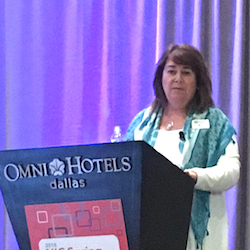
The tight labor market is preventing the construction of senior living communities and increasing wage pressure among operators, National Investment Center for Seniors Housing & Care Chief Economist Beth Burnham Mace told those attending a McKnight’s Online Expo session on capital market conditions on Thursday.
Workers’ increasing confidence in the economy also is making it more challenging for operators to keep employees, who believe they can find other jobs relatively easily, she said. Mace made similar remarks in a talk at the recently concluded NIC Spring Investment Forum in Dallas.
“One of my concerns for this sector is the impact that the tight labor market might have in terms of being able to staff a fairly care-intensive business,” she said Thursday. “And that’s staffing not just at the front line but all the way up through the executive director. We simply don’t have as many well-trained individuals as we need for our sector.”
Mace said that according to several capability analyses, “in some instances, where properties haven’t gone forward — the shovel hasn’t hit the dirt — it’s because there isn’t the labor there to take care of the residents who might come in.”
The jobless rate is nearing record lows, Mace said, adding that the nationwide unemployment rate in February was 4.1%. For context, she identified three other periods in recent decades with lower unemployment rates: the fourth quarter of 2000, when it was 3.9%; the first quarter of 1969, when it was 3.4%; and the second quarter of 1953, when it was 2.6%.
And unemployment rates were even lower in some markets as of December 2017, Mace said, citing as examples Portland, ME (1.8%); Nashville, TN (2.4%); Milwaukee, Austin, TX, and San Francisco (2.7%); Boston (2.8%); and Denver (2.9%). The rates in Atlanta and Seattle were right at 4.1%, she said.
Another issue affecting senior living, Mace said, is the mismatch between open positions and the skill sets of available workers. At the end of 2017, she said, there were 5.8 million job openings and 5.5 million hires. “There are more openings out there than there are people to be hired into those jobs,” Mace said. “We don’t really have the right labor skills for the jobs that are available.”
In addition to the economy affecting recruiting, it also is affecting retention. The number of people quitting jobs is increasing, she said, citing Bureau of Labor Statistics Data. This increase indicates that people have some confidence in the economy, Mace said, “because you wouldn’t really quit a job if you didn’t have a job to move into.”
Those tight labor market conditions have translated into upward pressure on wages, she said, noting that the senior housing sector is seeing wage growth of more than 5% on a year-over-year basis.
“And for all of 2017, in aggregate, it was about 4.9%, which is almost double what we saw in 2016,” Mace said. “And wage pressures are higher in the assisted living sector than they have been in the broader economy, where wage pressures have been up about 2.9% as of December.”
McKnight’s Online Expo sessions are available for listening online. Use the link here to register or log in.
See the links below under “Related Articles” for additional coverage of the 2018 NIC Spring Investment Forum.



